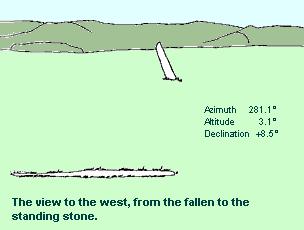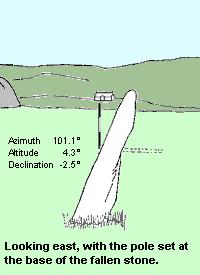
Ardalanish, Mull
Stones of Wonder
QUICK LINKS ...
HOME PAGE
INTRODUCTION
WATCHING
THE SUN, MOON AND STARS
THE
MONUMENTS
THE
PEOPLE AND THE SKY
BACKGROUND
ARCHAEOASTRONOMY
USING
THE SITE DESCRIPTION PAGES
VISITING
THE SITES
THE
LEY LINE MYSTERY
THE
SITES
ARGYLL
AND ARRAN
MID
AND SOUTH SCOTLAND
NORTH
AND NORTH-EAST SCOTLAND
WESTERN
ISLES AND MULL
Data
DATES
OF EQUINOXES AND SOLSTICES, 1997 to 2030 AD
DATES
OF MIDSUMMER AND MIDWINTER FULL MOONS, 1997 to 2030 AD
POSTSCRIPT
Individual
Site References
Bibliography
Links
to other relevant pages
Contact
me at : rpollock456@gmail.com
Standing Stone NM378189*
 How
to find: From Bunessan take the minor road going
south. After 2km a road on the right leads to a parking area and a path to the beach (Ardalanish
Bay). At the beach walk left (east) for about 400 metres. The stone is visible in a field behind
the dunes.
How
to find: From Bunessan take the minor road going
south. After 2km a road on the right leads to a parking area and a path to the beach (Ardalanish
Bay). At the beach walk left (east) for about 400 metres. The stone is visible in a field behind
the dunes.
Best time of year to visit: Any clear night in winter.
This site consists of a standing stone and a fallen stone which once stood in line with it. The standing stone is about two metres tall by 90cm wide and 30cm thick. The fallen stone lies 11 metres to the east, and is over two metres in length. It may be difficult to locate this latter stone in the long grass.
The broad faces of the standing stone indicate a line towards the prostrate stone, which seems to have fallen to the south. The line was surveyed as if the standing stone were set vertically (it now leans slightly towards the south) and by using a ranging pole set up at the base of the fallen stone.
 To the west, the bearing of 281.1° with a horizon height of just over 3° gives a declination
of +8.5°. This is of no obvious astronomical significance, though the line would indicate
the setting position of the Pleiades about 1500BC. However, the brightest star in this cluster
is magnitude 2.8, and the whole group would probably have been invisible at this horizon height.
Today the Pleiades ride much higher in the sky, close to the position of the sun at midsummer.
To the west, the bearing of 281.1° with a horizon height of just over 3° gives a declination
of +8.5°. This is of no obvious astronomical significance, though the line would indicate
the setting position of the Pleiades about 1500BC. However, the brightest star in this cluster
is magnitude 2.8, and the whole group would probably have been invisible at this horizon height.
Today the Pleiades ride much higher in the sky, close to the position of the sun at midsummer.
To the east, the bearing of 101.1° and a horizon of 4.5° gives us a declination of -2.5°. Again, the significance of this figure is not obvious. It is not a solar or lunar line. The declination is that of the star Betelgeuse about 2000BC, and it may be that the line indicates the rising of the constellation Orion, of which Betelgeuse is one of the higher stars. The horizon is high enough for such a stellar line to be viable. Today Orion is also higher in our skies, and is over half in view in a winter night when on the bearing indicated by the stones.
Neither of these lines is particularly convincing, and the stones at Ardalanish still hold their secrets.